Plants
Lantana Plant Care & Growth Guide – Thrive!

Welcome to our comprehensive guide on lantana plant care and growth. If you’re looking to add a burst of color and beauty to your garden or landscaping, lantanas are the perfect choice. These vibrant flowering perennials are known for their stunning clusters of small flowers in various shades. Whether you’re a seasoned gardener or a beginner, this guide will provide you with all the essential information you need to ensure your lantanas thrive and bring joy to your outdoor spaces.
Before we delve into the care requirements and growing tips, let’s get to know this remarkable plant. Lantana, also known as Lantana camara, belongs to the Verbenaceae family. It is a fast-growing perennial vine that can be grown as a shrub, ground cover, or even in hanging baskets. Lantanas are loved for their ability to attract butterflies and hummingbirds, making them a favorite among nature enthusiasts.
To ensure the success of your lantana plants, it’s crucial to understand their unique needs. From sunlight and soil requirements to pruning and propagation techniques, we’ll cover everything in detail. So, let’s dive in and learn how to create a thriving lantana garden!
Key Takeaways:
- Lantanas are fast-growing perennial vining shrubs that produce clusters of small, brightly colored flowers.
- They thrive in full sun, well-draining soil, and prefer temperatures above 55 degrees Fahrenheit.
- Regular pruning, fertilizing, and proper watering are essential for maintaining the health and beauty of lantana plants.
- There are various lantana varieties to choose from, offering a range of colors and growth habits.
- Lantanas can be propagated through stem cuttings or seed germination.
Lantana Plant Types and Varieties
Lantanas are known for their beautiful and vibrant flowers, and they come in various types and varieties, adding interest and color to any garden. Let’s explore some of the popular lantana varieties that you can consider for your own landscape:
Lantana montevidensis (trailing lantana): This variety is a perfect choice for hanging baskets and trailing over walls or containers. Trailing lantana produces clusters of small flowers in shades of purple, lavender, or white. It is a low-growing lantana that creates a cascading effect, adding dimension to your garden.
Lantana trifolia (popcorn lantana): The popcorn lantana variety features charming clusters of tiny flowers that resemble popcorn. It is a compact and bushy lantana, making it suitable for borders and edgings. This variety offers a wide range of colors, including yellow, orange, pink, and white, adding a playful touch to your garden.
Lantana urticoides (wild lantana): Wild lantana is a tall and upright variety, reaching heights of up to 6 feet. It produces clusters of flowers in shades of yellow, orange, and pink. Wild lantana is a great choice for creating a focal point or serving as a backdrop in your garden.
Lantana pastazensis: This unique lantana variety originates from the Andes in Ecuador. It features beautiful pink or white flowers with contrasting dark purple centers. Lantana pastazensis is a compact and mounding lantana that adds a touch of exotic beauty to your garden.
These are just a few examples of the lantana varieties available. In addition to the natural varieties, there are also cultivated lantana varieties that have been selectively bred for specific traits and characteristics. Some popular cultivated varieties include ‘Spreading Sunset’ and ‘Miss Huff’, known for their vibrant colors and vigorous growth.
When selecting lantana varieties for your garden, consider the growth habit, color, and height that best complements your overall landscape design. Whether you prefer cascading blooms, compact bushes, or tall and upright plants, there is a lantana variety to suit your preferences.
Lantana Plant Care Requirements
When it comes to caring for lantana plants, there are a few key requirements to keep in mind. By understanding their needs and providing the right conditions, you can ensure that your lantanas thrive and produce beautiful blooms. Here are the essential care guidelines for lantana:
1. Sunlight:
Lantanas are sun-loving plants and require full sun to flourish. They need at least six hours of direct sunlight each day to maintain their vibrant colors and promote healthy growth.
2. Soil:
Well-draining soil is essential for lantana plants. They prefer soil that is neutral or slightly acidic, with a pH level between 6.0 and 7.0. Ensure that the soil doesn’t become waterlogged, as excessive moisture can lead to root rot.
3. Watering:
Lantanas require regular watering, especially during dry spells. Water deeply, ensuring that the soil is moist but not soggy. It’s best to water at the base of the plant to prevent overhead wetting, which can lead to disease and fungal issues.
4. Temperature and Humidity:
Lantanas thrive in temperatures above 55 degrees Fahrenheit. They prefer warm and humid conditions, making them ideal for gardens in hot and tropical regions. If you live in a cooler climate, consider growing lantanas in containers that can be moved indoors during winter.
5. Fertilizing:
Fertilize lantana plants once a year with a slow-release fertilizer. If you’re growing lantanas in containers, you may need to fertilize them monthly to provide them with the necessary nutrients for healthy growth and abundant blooms.
6. Pruning:
Annual pruning is essential for lantanas to maintain their shape and encourage branching and flowering. Prune them in early spring to remove dead or damaged branches and to promote new growth. Regular deadheading, or the removal of spent flowers, also helps to stimulate continuous blooming.
7. Propagation:
Lantanas can be propagated through stem cuttings or seed germination. Stem cuttings are the preferred method, especially for hybrid varieties. Harvest a 4-inch cutting in the fall and root it in a moist seed starting mix or a mixture of perlite and peat moss. Seeds can also be harvested from ripe berries and germinated in small pots with soilless potting mix.
Remember to provide your lantana plants with the care they need, and they will reward you with an abundance of vibrant flowers and lush foliage. By following these care requirements, you can create a thriving lantana garden or enjoy the beauty of lantanas in containers.
| Care Requirement | Description |
|---|---|
| Sunlight | Provide lantanas with at least six hours of direct sunlight each day. |
| Soil | Use well-draining soil that is neutral or slightly acidic with a pH level between 6.0 and 7.0. |
| Watering | Water deeply, ensuring that the soil is moist but not waterlogged. |
| Temperature and Humidity | Lantanas thrive in temperatures above 55 degrees Fahrenheit and prefer warm and humid conditions. |
| Fertilizing | Apply a slow-release fertilizer once a year, or monthly for container-grown lantanas. |
| Pruning | Prune in early spring to remove dead or damaged branches and promote new growth. Regular deadheading stimulates continuous blooming. |
| Propagation | Propagate lantanas through stem cuttings or seed germination. |
Growing Lantana in the Garden
When it comes to growing lantana in your garden, selecting the right location is crucial for its success. Choose a sunny spot with well-draining soil to provide the ideal growing conditions for your lantana plants. While lantanas are known to be adaptable to various soil conditions, they prefer slightly acidic soil. If your soil is on the alkaline side, you can enhance its acidity by mulching with pine needles.
Spring is the best time to plant lantanas in your garden, once the threat of frost has passed. Once established, lantanas are relatively low-maintenance and can tolerate dry conditions, which makes them a popular choice for gardeners. They can thrive with thorough watering about once a week, but be sure not to overwater them as they dislike wet feet.
Give your lantana plants a light dose of fertilizer in the spring to provide them with the necessary nutrients for healthy growth and blooming. Pruning and deadheading are also essential for encouraging reblooming. Regularly remove spent flowers and trim back any leggy or unruly growth to encourage a bushier, more compact plant. This will not only keep your lantanas looking tidy but also promote more abundant blooms.
For a visual representation of growing lantana in the garden, refer to the table below:
| Planting | Watering | Fertilizing | Pruning |
|---|---|---|---|
| Choose a sunny location with well-draining soil | Water thoroughly about once a week | Provide a light dose of fertilizer in the spring | Regularly prune and deadhead to encourage reblooming |
| Prefer slightly acidic soil; mulch with pine needles for increased acidity if needed | Be careful not to overwater, as lantanas dislike wet feet | Trim back leggy or unruly growth for a bushier plant | |
| Plant in the spring after the threat of frost has passed | Remove spent flowers to promote continuous blooms |
Note: These are general guidelines for growing lantanas in the garden. Specific care requirements may vary depending on the lantana variety and your local climate conditions.
Now that you have a better understanding of how to grow lantana in your garden, let’s explore how lantanas can be successfully grown in containers in the next section.
Growing Lantana in Containers
One of the versatile options for landscaping with lantanas is growing them in containers. Whether you have limited space or want to add a pop of color to your patio or balcony, lantanas can thrive in pots. Here’s how to successfully grow lantana plants in containers:
Container Selection
Choose a container that is slightly larger than the plant’s rootball to allow room for growth. Ensure the pot has ample drainage holes to prevent waterlogging, which can lead to root rot. A well-draining potting soil is also essential for container-grown lantanas to thrive.
Soil Preparation
Use a well-draining potting soil and consider mixing in sand, perlite, or peat moss to improve drainage. This will help prevent water from accumulating around the roots, promoting healthy growth. Optimal soil conditions are crucial for lantanas to flourish.
Repotting
As lantanas grow, their roots may outgrow the container. When this happens, it’s time to repot them into a slightly larger container. Ensure that the new pot has sufficient drainage holes and use fresh potting soil to promote the healthy development of your lantanas.
Placement and Watering
Place your lantana pots in a sunny location, as they require at least six hours of direct sunlight each day. Regular watering is essential, and you should water them whenever the top inch of soil feels dry to the touch. However, be cautious not to overwater, as lantanas can be sensitive to waterlogged conditions.
Overwintering
In colder climates, lantanas can be brought indoors for the winter. Find a bright location where they can receive adequate light, such as near a south-facing window. Water them minimally during this time, as they require less moisture in the dormant season.
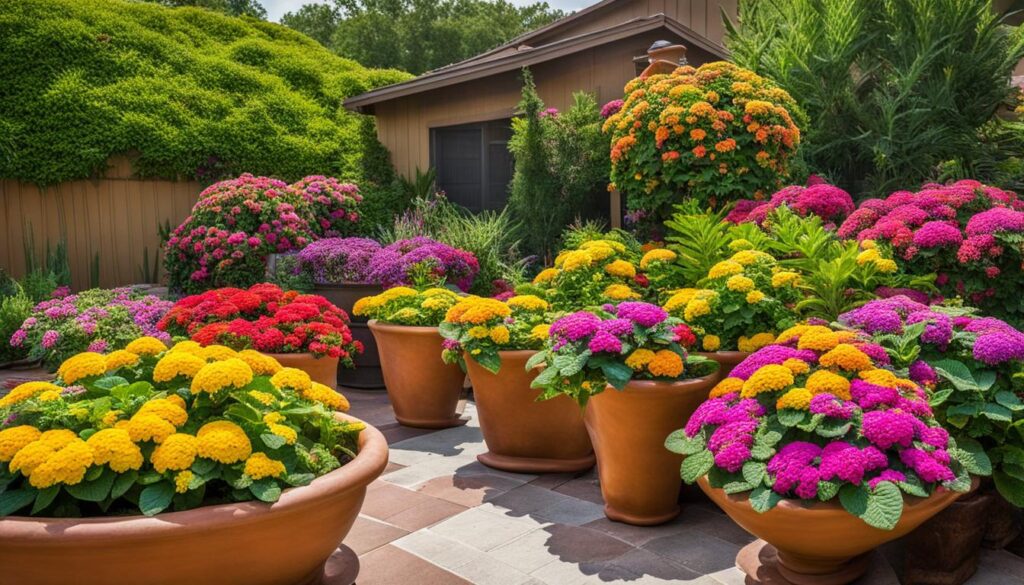
Growing lantanas in containers can add a vibrant touch to your garden, patio, or balcony. The portability of container-grown lantanas allows you to experiment with different placements and rearrangements, making them an excellent choice for lantana landscaping. With proper care, these container plants will reward you with beautiful blooms and an inviting atmosphere.
Propagating Lantana Plants
Propagating lantana plants is a rewarding way to expand your collection and create new plants for your garden or landscape. There are two common methods for propagating lantanas: stem cuttings and seed germination.
Stem Cuttings
Stem cuttings are the most reliable method for propagating hybrid varieties of lantanas. It’s best to take 4-inch cuttings in the fall when the plant has finished flowering for the season. Follow these steps to propagate lantanas from stem cuttings:
- Choose a healthy, non-woody stem for the cutting.
- Remove any leaves from the lower half of the stem.
- Dip the cut end of the stem into rooting hormone (optional but recommended).
- Plant the cutting in a moist seed starting mix or a mixture of perlite and peat moss.
- Cover the cutting with a clear plastic bag to create a mini greenhouse.
- Place the cutting in a warm location with indirect light.
- Provide support to ensure the bag doesn’t touch the cutting.
- Keep the soil moist but not waterlogged.
- After 4-6 weeks, the cutting should develop roots.
- Once the roots are well-established, transplant the cutting into a larger pot or your garden.

Seed Germination
Another method for propagating lantanas is through seed germination. This method works well for both hybrid and non-hybrid varieties. Here’s how you can propagate lantanas from seeds:
- Harvest ripe berries from the lantana plant.
- Remove the seeds from the berries and clean them.
- Soak the seeds in warm water overnight to soften the seed coat.
- Plant the seeds in small pots filled with a soilless potting mix.
- Moisten the potting mix and cover the pots with plastic wrap.
- Place the pots in a warm environment with indirect light.
- Keep the potting mix moist until the seeds germinate, which usually takes 2-3 weeks.
- Once the seedlings emerge, remove the plastic wrap and continue to care for them as you would for mature lantanas.
Whether you choose to propagate lantanas from stem cuttings or seeds, be patient and consistent with your care to ensure successful propagation. With a little time and effort, you can easily multiply your lantana collection and enjoy these beautiful plants in various areas of your garden or landscape.
Lantana Plant Diseases and Pests
While lantanas are generally resistant to most pests and diseases, there are a few common issues that can affect these beautiful plants. Understanding and addressing these problems promptly can help ensure the health and vitality of your lantanas.
Common Pests
Lantana plants can be susceptible to various pests, including:
- Aphids
- Lace bugs
- Mealybugs
- Whiteflies
- Spider mites
To eliminate these pests, you can use insecticidal soap. Simply dilute the soap according to the product instructions and spray it on the affected areas of the plant. Repeat the treatment as needed until the pests are under control.
Disease Prevention
Two common diseases that can affect lantanas are powdery mildew and root rot.
Powdery mildew is a fungal infection that appears as a white, powdery growth on the leaves. It usually occurs when the plant is not receiving enough light or if the air circulation is poor. To prevent powdery mildew, ensure that your lantanas are planted in a location that receives ample sunlight and has good air circulation.
Root rot can occur if the lantana plants are overwatered, leading to excessive moisture around the roots. To prevent root rot, it is important to provide well-draining soil and avoid overwatering. Allow the soil to dry out between watering sessions and avoid creating a waterlogged environment for the roots.
Pruning is also an important aspect of lantana plant care. Regularly trim off any dead or infected foliage to prevent the spread of diseases and maintain overall plant health.
In summary, while lantanas are generally hardy and resistant to most pests and diseases, it is important to be aware of these potential issues. By following the proper care guidelines, providing adequate sunlight, good air circulation, and monitoring water levels, you can help keep your lantanas thriving and beautiful.
Lantana Plant Maintenance
To ensure the healthy growth and continuous blooming of your lantanas, it is essential to provide them with proper maintenance. Lantanas thrive when they receive full sun and consistently moist soil. The combination of these factors allows them to showcase their stunning tubular, star-like flowers in vibrant colors, which are complemented by their coarse, deep green leaves. Their blooming period extends throughout the year in warm climates above 55 degrees Fahrenheit, attracting delightful butterflies and hummingbirds to your garden.
Regular deadheading, pruning, and fertilizing are key maintenance practices that contribute to the overall well-being of your lantanas. Deadheading involves removing the faded flowers, which not only keeps your plants looking tidy but also encourages new flower growth. Pruning should be done annually to promote branching and maintain a compact shape. Additionally, it rejuvenates the plant for healthier and more vigorous blooms. Fertilizing should be carried out according to the specific needs of your lantanas, ensuring they receive the necessary nutrients for optimal growth.
By following these maintenance practices, you can keep your lantanas healthy and thriving, ensuring a beautiful display of their vibrant blooms throughout the year.
| Maintenance Tasks | Frequency |
|---|---|
| Deadheading | Regularly |
| Pruning | Annually |
| Fertilizing | As needed |
Lantana Plant Lifespan and Hardiness
When considering adding lantanas to your garden, it’s important to understand their lifespan and hardiness. Lantanas are classified as tender perennials, meaning they can live for two to five years in warm areas. However, their hardiness varies depending on the USDA zones.
In USDA zones 7-11, lantanas are considered hardy plants and can withstand various environmental conditions. They are known for their ability to tolerate drought, making them an ideal choice for arid regions. With their resilience and adaptability, lantanas can thrive even in challenging landscapes.
However, it’s essential to note that lantanas are susceptible to frost damage. In colder regions where freezing temperatures are common, lantanas are often treated as annuals. This means they are planted and enjoyed for one season before being replaced with new plants the following year.
To ensure the longevity of your lantanas, it’s crucial to provide them with the right care and growing conditions. Adequate sunlight, well-draining soil, and regular watering are key factors in extending their lifespan. Additionally, providing a layer of mulch around the base of the plants can help retain moisture and protect the root system.
Conclusion
Lantana plants are a vibrant and versatile addition to any garden or landscaping project. Their eye-catching flowers in various colors add a pop of beauty to outdoor spaces, attracting pollinators such as butterflies and hummingbirds. Whether you are an experienced gardener or a newcomer to the world of plants, lantanas are an excellent choice for their low maintenance requirements and stunning blooms.
By following the proper care and maintenance guidelines, lantanas can thrive and provide continuous blooms throughout the growing season. Ensure that your lantana plants receive at least six hours of direct sunlight and are planted in well-draining soil. Regular pruning and deadheading will encourage new growth and flowering. Additionally, lantanas tolerate dry conditions, making them a drought-tolerant option for water-wise gardens.
With their long lifespan of up to five years and ability to tolerate various soil and climate conditions, lantana plants are a reliable choice for any garden. These hardy perennials can bring joy and color year after year, adding a touch of beauty to your outdoor space. So, whether you’re looking to enhance your garden or create an attractive landscape, consider incorporating lantana plants for their vibrant flowers and easy care. Yes, the care tips for lantana plants can also apply to prayer plants. Both plants require well-draining soil, bright indirect light, and regular watering. However, prayer plants also benefit from higher humidity levels. For more detailed information, you can refer to a prayer plant care guide for specific instructions. Lantana is a fast-growing perennial vining, flowering shrub that produces rounded clusters of small, brightly colored flowers in various shades. It is commonly used in hanging baskets or as ground covers. Lantanas come in various types and varieties, including Lantana montevidensis (trailing lantana), Lantana trifolia (popcorn lantana), Lantana urticoides (wild lantana), and cultivated varieties such as ‘Spreading Sunset’ and ‘Miss Huff’. Lantanas thrive in full sun and well-draining soil, requiring at least six hours of direct sunlight. They prefer temperatures above 55 degrees Fahrenheit and high humidity. Regular watering and annual fertilizer application are recommended. Pruning is necessary for branching and flowering. Choose a sunny location with well-draining soil and slightly acidic conditions. Plant lantanas in the spring after the threat of frost has passed. Once established, they are relatively low-maintenance and can tolerate dry conditions. Regular pruning and deadheading promote reblooming. Yes, lantanas can be grown in containers. Choose a slightly larger pot with ample drainage holes, use well-draining potting soil, and water them regularly. In colder climates, lantanas can be brought indoors and overwintered with adequate light and minimal watering. Lantanas can be propagated through stem cuttings or seed germination. Stem cuttings from non-woody growth can be rooted in moist seed starting mix or a perlite and peat moss mixture. Seeds can be harvested from ripe berries and germinated in small pots with soilless potting mix. Common pests include aphids, lace bugs, mealybugs, whiteflies, and spider mites. Insecticidal soap can be used to eliminate these pests. Powdery mildew and root rot can occur due to improper care. Regular pruning, watering, and maintaining good air circulation can help prevent these issues. Regular deadheading, pruning, and fertilizing can help maintain the plant’s health and encourage continuous blooming. Lantanas require full sun and consistently moist soil to bloom. They are generally low-maintenance and tolerant of drought conditions. Lantanas are considered tender perennials and can live for two to five years in warm areas. They are hardy in USDA zones 7-11 and can tolerate drought conditions. Frost can kill lantanas, so in colder regions, they are often treated as annuals. Lantana plants are a versatile and colorful addition to any garden or landscaping project. With their vibrant flowers, low maintenance requirements, and ability to attract pollinators, lantanas are a popular choice for both experienced and novice gardeners.-Can the Care Tips for Lantana Plants Also Apply to Prayer Plants?
FAQ
What is a lantana plant?
What are some types and varieties of lantana?
What are the care requirements for lantana plants?
How do I grow lantana in the garden?
Can I grow lantana in containers?
How can I propagate lantana plants?
What are common diseases and pests that affect lantana plants?
How do I maintain lantana plants?
How long do lantana plants live, and are they hardy?
Why should I grow lantana plants?
- About the Author
- Latest Posts
Meet Bethia, the visionary designer at ByRetreat who brings a touch of magic to every remote workspace she creates. With a boundless imagination and an eye for beauty, Bethia is passionate about transforming ordinary spaces into extraordinary havens of creativity and comfort.
Bethia possesses a unique talent for envisioning the perfect combination of furniture, colors, and textures that harmonize seamlessly in a room. She understands that selecting furniture goes beyond mere functionality; it’s about curating pieces that evoke a sense of style and sophistication while enhancing the overall ambiance.
Plants
Ideal Hydrangea Spots: Best Place to Plant Hydrangeas
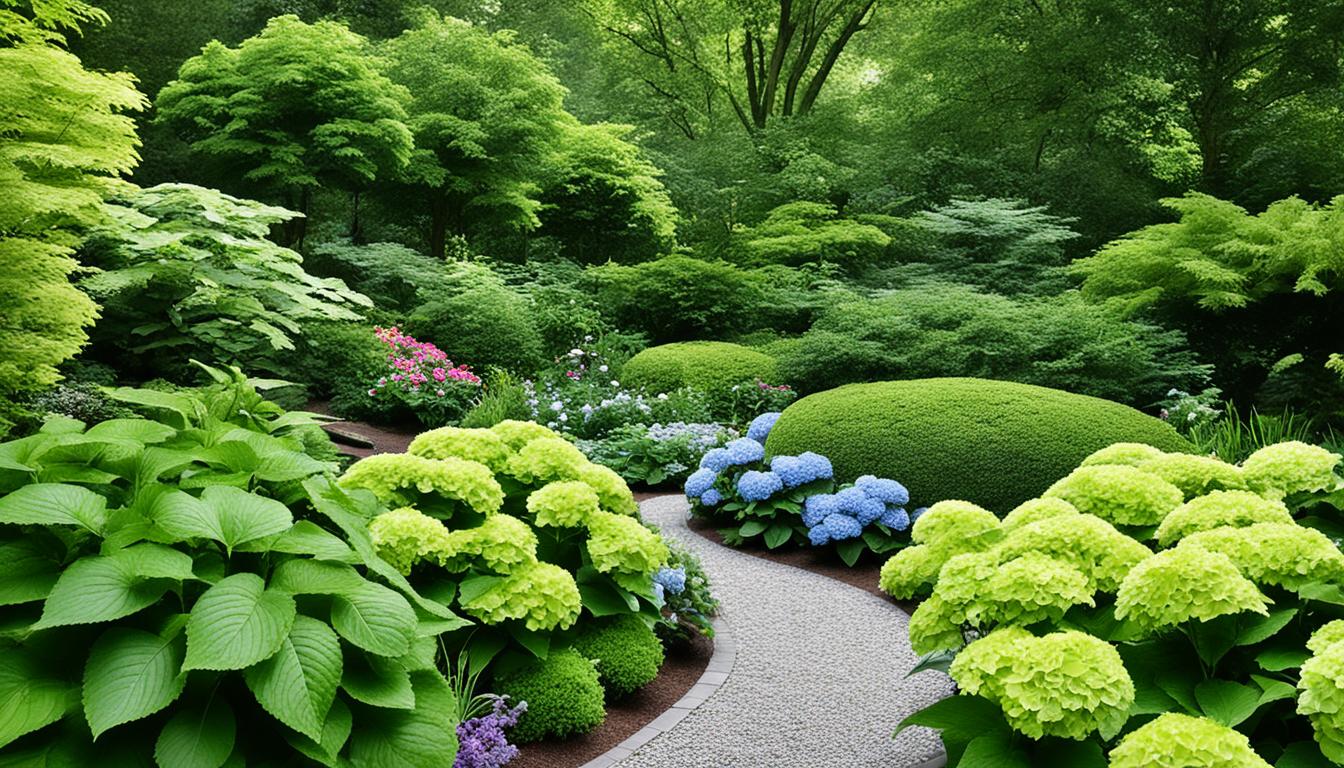
Did you know that the location where you plant your hydrangeas can have a significant impact on their growth and vibrancy? Finding the best place to plant hydrangeas is essential for optimal growth and to ensure that you get the most beautiful blooms.
In this guide, we will explore the different factors to consider when selecting the ideal spot for your hydrangeas. Whether you have a sunny garden or a shady corner, we’ll help you choose the right hydrangea varieties to thrive in various sun and shade conditions. By understanding their sunlight preferences and caring for them properly, you can enjoy vibrant and healthy hydrangea blooms year after year.
Key Takeaways:
- Choosing the right location is crucial for the growth and vibrancy of hydrangeas.
- Hydrangeas can thrive in different sunlight conditions, from full sun to partial shade.
- Consider the specific sunlight needs of different hydrangea varieties for optimal results.
- Proper care, including pruning, fertilizing, and watering, is essential for healthy blooms.
- By following our planting guide and care tips, you can transform your garden with stunning hydrangea displays.
Hydrangeas for Part Shade: Give Us Some Sunblock Please
When it comes to creating the perfect environment for hydrangeas, finding the right balance of sun and shade is key. While some hydrangea varieties thrive in full sun, others prefer a location with partial shade, where they can benefit from the morning sun and enjoy relief from the scorching afternoon rays. These hydrangeas are like beachgoers who know the importance of sunblock, seeking a little shade to protect themselves from the intense heat.
In the family of hydrangeas, there are several popular cultivars that are well-suited for part shade conditions. These varieties have the ability to produce stunning blooms when provided with a combination of filtered light and a few hours of full sun. Among them are the beloved Endless Summer® Hydrangea series, which includes BloomStruck®, Endless Summer®, Blushing Bride®, and Twist-n-Shout®.
Another great choice for morning sun and afternoon shade is the Annabelle Hydrangea, which is known for its spectacular large white flowers. And let’s not forget the many bigleaf hydrangea cultivars that can handle part shade and reward you with their vibrant blossoms.
Here are a few remarkable hydrangea varieties that thrive in part shade:
| Hydrangea Variety | Light Requirements |
|---|---|
| Endless Summer® series (BloomStruck®, Endless Summer®, Blushing Bride®, Twist-n-Shout®) | Morning sun, afternoon shade |
| Annabelle Hydrangea | Morning sun, afternoon shade |
| Bigleaf hydrangea cultivars | Morning sun, afternoon shade |
These hydrangeas have adapted to thrive in part shade by enjoying the gentle morning sun and being sheltered from the intense afternoon heat. This combination of light conditions allows them to produce their enchanting blooms and add a touch of elegance to any garden or landscape.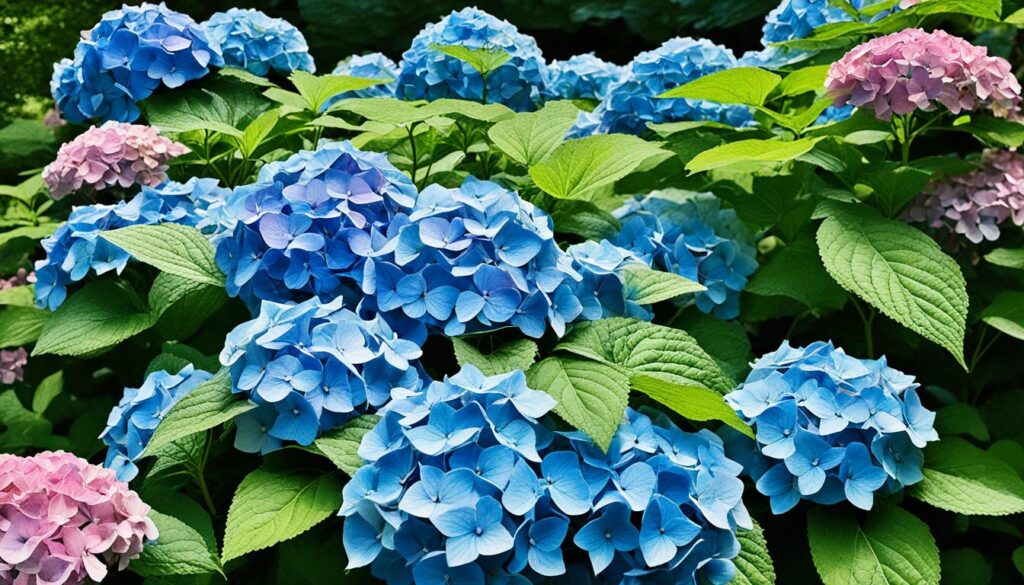
So, if you have a garden or yard with a mix of sunlight and shade, don’t worry! There are plenty of beautiful hydrangeas that will thrive in this environment. Just give them some sunblock (in the form of morning sun) and watch as their blooms light up your space with their breathtaking beauty.
Hydrangeas for Full Sun: We Like It Sunny
While most hydrangeas prefer some shade, there are certain varieties that can thrive in full sun. If your garden gets plenty of sunlight, don’t worry! There are hydrangeas that will flourish in these conditions and reward you with beautiful blooms.
Panicle Hydrangeas
Panicle hydrangeas, known for their cone-shaped flower clusters, are excellent choices for full sun exposure. They can tolerate the direct heat and intense sunlight, making them perfect for sunny spots in your garden. Some popular panicle hydrangeas include:
- Fire Light®
- Limelight
- Pinky Winky®
- Strawberry Sundae®
- Vanilla Strawberry®
Dwarf Varieties
If you have limited space or prefer compact hydrangeas, consider the Let’s Dance® and Cityline® series. These dwarf varieties are perfect for both full sun and part sun environments. They offer the beauty of hydrangeas in a smaller package without compromising on vibrant blooms.
Smooth Hydrangeas
Smooth hydrangeas are another type that can handle full or part sun conditions. These varieties are known for their large rounded flower heads and are a great choice for a sunny garden. Consider the following smooth hydrangeas:
- Incrediball®
- Invincibelle® Ruby
With these hydrangeas, you can enjoy the beauty and charm of these flowering plants even in full sun areas. Just make sure to provide them with proper care and maintenance, including regular watering and occasional fertilization.
Overall, including hydrangeas that thrive in full sun can add a splash of color and vibrancy to your garden. Whether you choose panicle hydrangeas, dwarf varieties, or smooth hydrangeas, these sun-loving beauties will brighten up any sunny corner of your outdoor space.
Growing Hydrangeas in Different Sun and Shade Conditions
When it comes to growing hydrangeas, understanding their sunlight requirements is essential for their success. While many hydrangea varieties thrive in partial shade, oakleaf hydrangeas are known for their adaptability to different sun and shade conditions.
In the northern parts of the United States, oakleaf hydrangeas can tolerate full sun. However, in warmer and southern climates, they prefer some afternoon shade to protect them from excessive heat and sun exposure. This makes them an excellent choice for those looking to plant hydrangeas in regions with varying temperature and sunlight conditions.
What makes oakleaf hydrangeas unique is their ability to also tolerate full shade. This makes them ideal for areas of the garden that receive little to no direct sunlight. Whether it’s a densely shaded corner or underneath taller trees, oakleaf hydrangeas can thrive and add beauty to areas that are typically challenging for other hydrangea varieties.
It’s important to note that while oakleaf hydrangeas are the most adaptable, other hydrangea varieties have specific sunlight needs. When selecting the location for planting, it’s crucial to consider the specific requirements of each hydrangea type to ensure optimal growth and vigor.
By carefully assessing the sunlight conditions in your garden and selecting the appropriate hydrangea varieties, you can create a diverse and captivating display of hydrangeas that thrive in different sun and shade conditions.
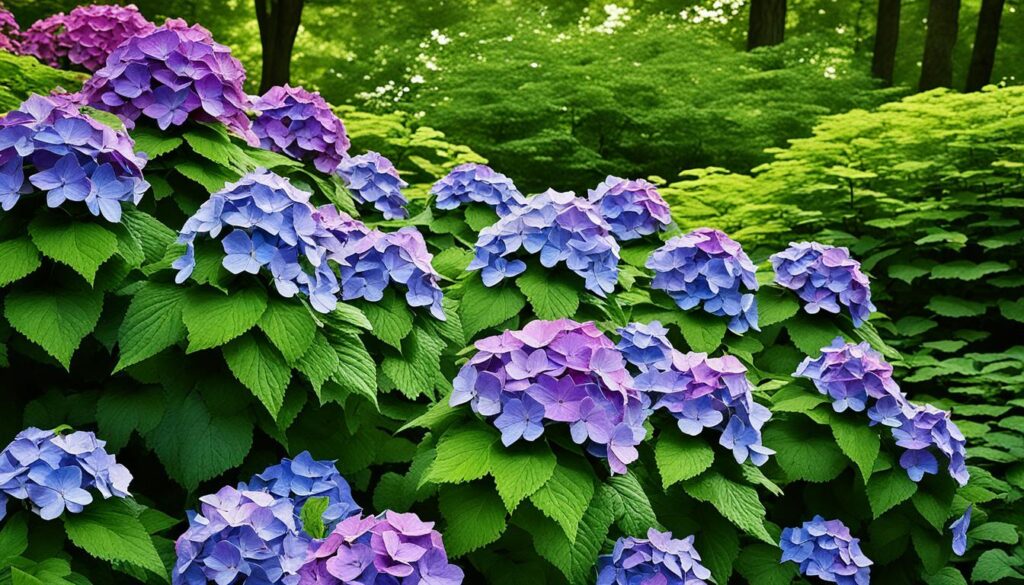
Pruning and Caring for Hydrangeas
Proper pruning and care are essential for the health and vitality of hydrangeas. By implementing appropriate pruning techniques and providing the necessary care, gardeners can ensure the longevity and abundant blooming of their hydrangea plants. Here are some important tips to consider:
Understanding Pruning Methods
When pruning hydrangeas, it’s crucial to understand whether the plant blooms on old wood or new wood. This knowledge will help gardeners avoid accidentally cutting off next season’s flowers.
Tip: Prune hydrangeas that bloom on old wood immediately after flowering. This allows for new growth and development of flower buds for next year. On the other hand, hydrangeas that bloom on new wood can be pruned during late winter or early spring before new growth begins.
Optimal Soil Conditions
Hydrangeas thrive in well-drained soil that is rich in organic matter. A mixture of compost and native soil is ideal for providing the necessary nutrients and moisture retention.
Fertilizing for Healthy Blooms
To promote healthy blooming, it’s recommended to fertilize hydrangeas with a slow-release fertilizer that is high in phosphorus. Phosphorus is essential for promoting flower production and overall plant vitality.
Preventing Leaf Scorch
Hydrangeas are susceptible to leaf scorch, especially during hot and dry periods. To prevent leaf scorch, it’s important to provide hydrangeas with extra water and ensure they have adequate moisture in the soil.

Summary of Pruning and Care Tips
| Pruning Method | Soil Conditions | Fertilizing | Preventing Leaf Scorch |
|---|---|---|---|
| Prune hydrangeas that bloom on old wood immediately after flowering | Well-drained soil with organic compost | Use slow-release fertilizer high in phosphorus | Provide extra water during hot and dry periods |
By following these pruning and care tips, hydrangea enthusiasts can enjoy lush, vibrant blooms year after year. With proper maintenance, these stunning plants will continue to beautify gardens and landscapes.
Conclusion
Planting hydrangeas in the best location and providing proper care and maintenance are key to achieving beautiful and vibrant blooms. By selecting the right spot that balances sun and shade, ensuring well-drained soil, and following recommended pruning and watering practices, gardeners can enjoy the full potential of their hydrangea plants. With the right planting and care, hydrangeas can transform any garden into a colorful and inviting space.FAQ
What is the best place to plant hydrangeas?
What are the best types of hydrangeas for morning sun and afternoon shade?
Can hydrangeas grow in full sun?
Which hydrangea varieties are best for full shade?
How should I prune and care for hydrangeas?
Are there any tips for planting and caring for hydrangeas?
- About the Author
- Latest Posts
Meet Katherine, the creative enthusiast at ByRetreat who infuses her boundless passion for design into every remote workspace she crafts. With an innate sense of creativity and an eye for unconventional beauty, Katherine brings a unique and inspiring perspective to the team.
Katherine’s love for design is infectious, and her ability to think outside the box sets her apart. She believes that true artistry lies in embracing a variety of styles and mixing them harmoniously to create captivating spaces. By combining different textures, colors, and patterns, Katherine weaves a tapestry of creativity that breathes life into each remote workspace.
Plants
Grow Zucchini Successfully: Best Way & Tips

Did you know that zucchini plants are susceptible to squash vine borers, a pest that can quickly kill the plants by cutting off the flow of water? The impact of these destructive borers can be devastating to your zucchini harvest. However, by following the best practices and tips for growing zucchini, you can ensure successful cultivation and enjoy a bountiful harvest.
Whether you are a seasoned gardener or a novice looking to try your hand at gardening, this article will provide you with valuable insights on the best way to grow zucchini and tips for successful cultivation. From avoiding squash vine borers to proper planting techniques, soil requirements, spacing, and pollination, we will cover everything you need to know to grow zucchini successfully.
Key Takeaways:
- Delay planting zucchini until mid-July or use row covers to prevent squash vine borers
- Start zucchini from seeds or seedlings and choose the right time to plant
- Provide well-draining soil enriched with organic material for optimal growth
- Space zucchini plants at least 3-4 feet apart and consider trellising for better air circulation
- Ensure proper pollination for optimal fruit production and harvest zucchini at any size
Planting and Germination
Zucchini, a popular summer squash variety, can be easily grown from seeds or seedlings. While starting zucchini indoors is an option, direct sowing in the ground is the preferred and most common method of planting zucchini seeds. Here’s a step-by-step guide to planting zucchini seeds and ensuring successful germination:
1. Prepare the Soil
Before starting zucchini indoors or sowing the seeds outside, it’s crucial to have well-prepared soil. Ensure the soil is loose, rich in organic matter, and drains well. Incorporating compost or aged manure can greatly improve the soil’s fertility. Measure the soil temperature and wait until it consistently reaches above 55 degrees Fahrenheit for successful germination.
2. Planting Zucchini Seeds
When the soil is ready, plant the zucchini seeds about an inch deep into the soil. Space the seeds at least 3 feet apart to allow ample room for growth. Lightly mist the top of the soil with water to ensure proper moisture levels for the germination of zucchini. Take care not to overwater the seeds, as it can lead to rotting.
Pro Tip: For those who prefer starting zucchini indoors, plant the seeds in peat pots or biodegradable seed starting trays about 2-3 weeks before the last expected frost. Transplant the seedlings outdoors once the soil temperature is suitable.
3. Germination and Thinning
The germination period of zucchini seeds typically ranges from 5 to 10 days. During this time, it’s important to keep the soil consistently moist but not waterlogged. Once the seedlings reach a height of around 3 inches and develop 2 sets of true leaves, it’s time to thin them out. Starting zucchini indoors often leads to more seedlings, so removing the weaker ones will allow the strongest ones to flourish.
4. Timing is Key
For optimal growth, it’s crucial to plant zucchini at the right time. Zucchini thrives in warm soil, so direct sowing should take place in the second half of May when the risk of frost has passed and the soil has warmed up. This timing ensures that the young seedlings will not succumb to cold temperatures.
“Direct sowing zucchini seeds is the most practical and successful method for home gardeners. The plants quickly establish themselves and produce abundant healthy foliage and fruit.” – Gardening Expert, Jessica Washington
By following these planting zucchini seeds and germination guidelines, you can give your zucchini plants a head start in their growth journey. Whether you choose to start the seeds indoors or directly sow them in the ground, with proper care and attention, you’ll soon be rewarded with healthy zucchini plants ready to produce an abundance of delicious squash.
| Benefits of Direct Sowing Zucchini Seeds | Benefits of Starting Zucchini Indoors |
|---|---|
| 1. Simplifies the planting process | 1. Provides an earlier start to the growing season |
| 2. Minimizes transplant shock | 2. Offers more control over seedling development |
| 3. Allows seeds to germinate and grow in their natural environment | 3. Enables better protection against adverse weather conditions |
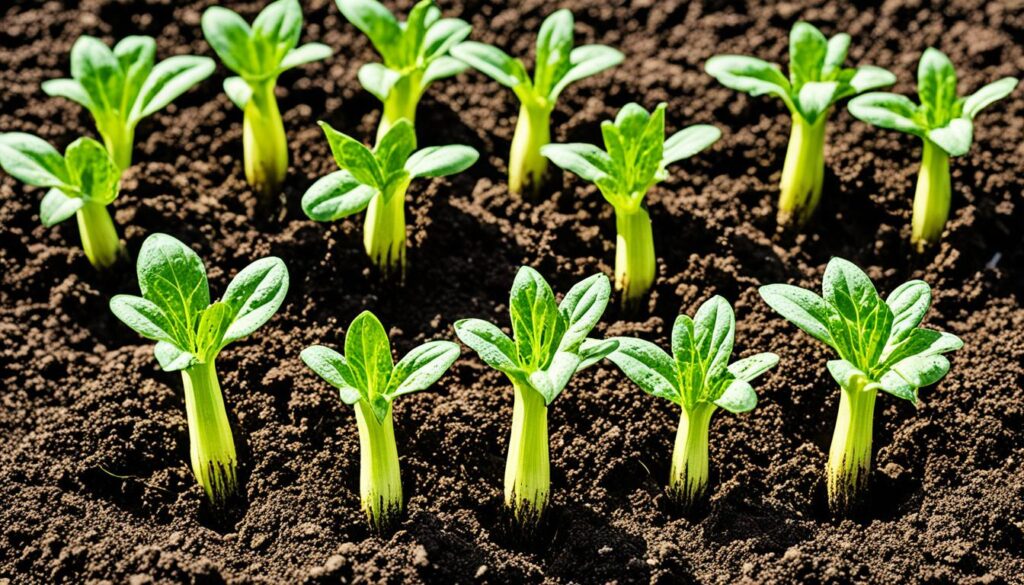
Soil and Location Requirements
Zucchini plants require specific soil and an ideal location to thrive and produce a bountiful harvest. Providing the right conditions for your zucchinis will ensure their health and productivity.
Choosing the Best Soil
Zucchini plants prefer organically rich, fertile, and well-draining soil. When planting in raised beds or containers, it is essential to select a well-draining potting soil. To enhance the soil’s fertility, add organic material or compost at the time of planting. This will help create a nutrient-rich environment for the zucchini plants to thrive.
If you are planting zucchinis directly in the ground, it is crucial to amend the soil with rich organic material or compost. This will improve the soil’s texture and provide the necessary nutrients for the plants to grow strong and healthy. Additionally, good drainage is essential for zucchini plants, as they prefer moist but not waterlogged conditions.
Choosing the Ideal Location
When selecting a location for your zucchini plants, it is important to consider their sunlight requirements. Zucchinis thrive in areas that receive full sun for at least 6-8 hours a day. Choose an area in your garden that is not shaded by buildings or trees, as this can hinder their growth and development.
Furthermore, it is important to note that zucchinis should not be planted in soil where other cucurbits (such as pumpkins or cucumbers) were grown in the past 1-2 years. This practice helps prevent the spread of diseases and pests that may affect the zucchini plants.
By providing the right soil conditions and selecting an ideal location with ample sunlight, you will create an optimal environment for your zucchini plants to flourish and produce an abundant crop.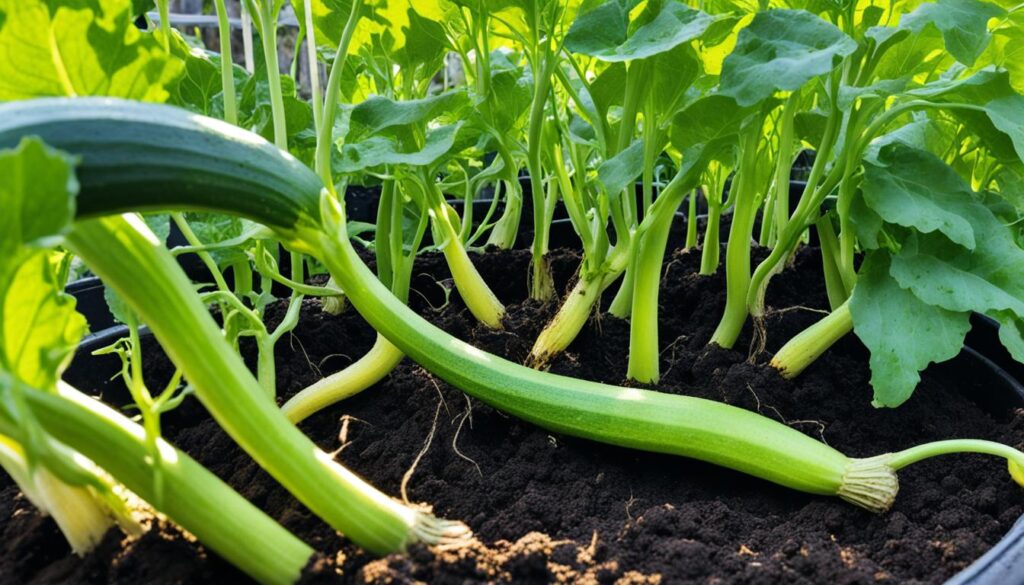
“Zucchini plants prefer organically rich, fertile, and well-draining soil. Provide the right conditions to help your zucchini plants thrive and produce a bountiful harvest.”
Spacing and Trellising
Proper spacing and trellising techniques are essential for the successful growth and development of zucchini plants.
Spacing Zucchini Plants
When it comes to zucchini plant spacing, giving enough room for each plant is crucial for optimal growth. It is recommended to space zucchini plants at least 3-4 feet apart, whether planting them in hills or rows.
For planting in hills, a general guideline is to plant 3 zucchinis per hill in a triangle pattern. Ensure the hills are also spaced 3-4 feet apart to provide enough space for the plants to receive nutrients and expand their root systems.
If growing zucchinis in containers, create a mound in the center of the container and plant three zucchinis around it. This arrangement allows for adequate airflow and efficient use of space while providing the plants with the necessary growing area.
Trellising Zucchini
Another option for maximizing space and aiding in pest management is trellising zucchini plants. By training them to grow vertically along a trellis or stakes, you can create a visually appealing and space-saving garden.
When trellising zucchini, ensure that the trellis or stakes are sturdy enough to support the weight of the plants and their fruit. As the zucchinis grow, gently guide the vines and tendrils toward the trellis, securing them with twist ties or plant clips.
The benefits of trellising zucchini include improved air circulation, which helps prevent disease, easier harvesting, and reduced pest damage since the plants are elevated off the ground.
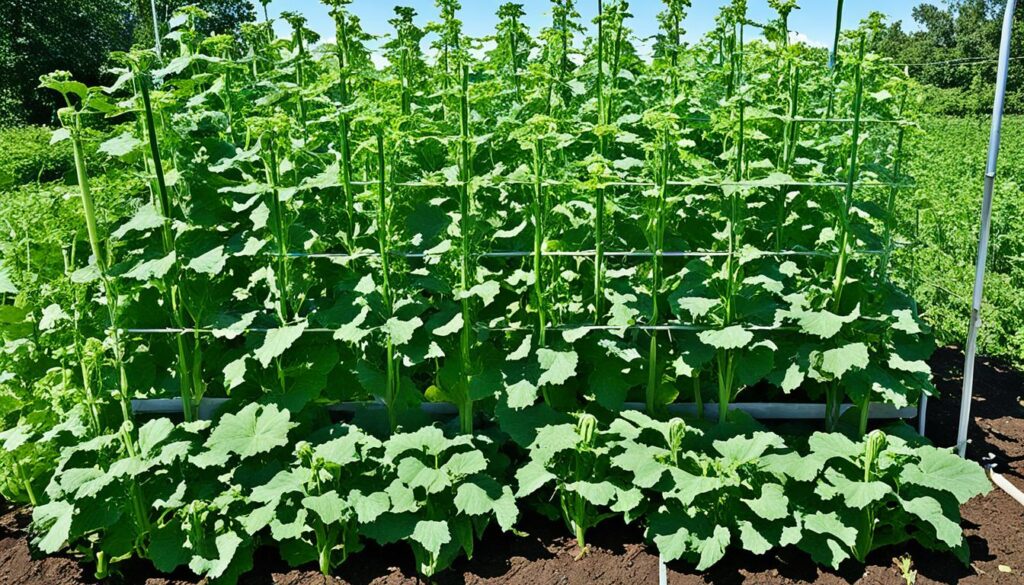
Implementing proper spacing and trellising techniques ultimately promotes healthier zucchini plants, increased productivity, and efficient use of garden space.
Pollination and Fruit Production
Zucchini plants rely on pollination for fruit production. These plants have separate male and female flowers, and the transfer of pollen from the male to the female flowers is crucial for the development of zucchini fruits. To ensure successful pollination, it’s important to understand how pollinators play a role in this process. 
Pollinators such as bees, butterflies, and other insects are attracted to the bright yellow flowers of zucchini plants. To maximize their presence in your garden, consider planting companion flowers like borage, catmint, dill, or dahlias nearby. These flowers will help attract pollinators, increasing the chances of successful pollination.
In some cases, there may be a lack of natural pollination due to factors such as weather conditions or a limited number of pollinators in the area. In such situations, manual pollination can be done to ensure fruit production. This process involves using a small brush or cotton swab to transfer pollen from the male flowers to the female flowers. By gently brushing the inside of the male flower and then transferring the pollen to the stigma of the female flower, you can help facilitate pollination.
Tip: To identify male and female flowers, look for the presence of a small zucchini-shaped swelling at the base of the female flower. Male flowers, on the other hand, do not have this swelling.
Proper pollination is essential for optimal fruit development. It ensures that the female flowers receive the necessary pollen for fertilization, leading to the formation of healthy zucchini fruits. Be sure to monitor the progress of your zucchini plants and check for signs of fruits developing from the female flowers.
When it comes to harvesting zucchini, you can do so at any size. However, larger zucchinis may have more developed seeds and a denser texture, which might not be desirable for certain recipes. In such cases, it is recommended to remove the seeds before consumption. This can be done by slicing the zucchini lengthwise and scooping out the seeds with a spoon.
Conclusion
Successful zucchini cultivation requires attention to several key factors, including avoiding squash vine borers, following proper planting techniques, providing the right soil and location, spacing plants correctly, and ensuring proper pollination. By implementing these tips and techniques, gardeners can enjoy a bountiful harvest of zucchinis that can be incorporated into a wide range of dishes.
The best way to grow zucchini is to start by carefully timing the planting, ensuring that soil temperatures are consistently above 55 degrees Fahrenheit. This warm soil temperature provides an ideal environment for germination and growth. Additionally, choosing a well-lit area with full sun for at least 6 hours a day will help zucchinis thrive.
When it comes to soil and location requirements, zucchini plants prefer organically rich and well-draining soil. Amend the soil with compost or rich organic material to promote healthy growth. Adequate spacing is essential for proper plant development, with a recommended distance of 3-4 feet between plants. Trellising zucchini plants can also save space and improve airflow.
Finally, ensuring proper pollination is crucial for maximizing fruit production. Planting companion flowers near zucchinis can attract beneficial pollinators, and manual pollination can be done to supplement natural pollination. Harvesting can be done at any size, but larger zucchinis may require seed removal before consumption.FAQ
When is the best time to plant zucchini?
How can I prevent squash vine borers from killing my zucchini plants?
What type of soil do zucchini plants prefer?
How should I space my zucchini plants?
Do zucchini plants require manual pollination?
Can I grow zucchini vertically?
- About the Author
- Latest Posts
Meet Katherine, the creative enthusiast at ByRetreat who infuses her boundless passion for design into every remote workspace she crafts. With an innate sense of creativity and an eye for unconventional beauty, Katherine brings a unique and inspiring perspective to the team.
Katherine’s love for design is infectious, and her ability to think outside the box sets her apart. She believes that true artistry lies in embracing a variety of styles and mixing them harmoniously to create captivating spaces. By combining different textures, colors, and patterns, Katherine weaves a tapestry of creativity that breathes life into each remote workspace.
Plants
Best Conditions for Ginger Root Growth Explained
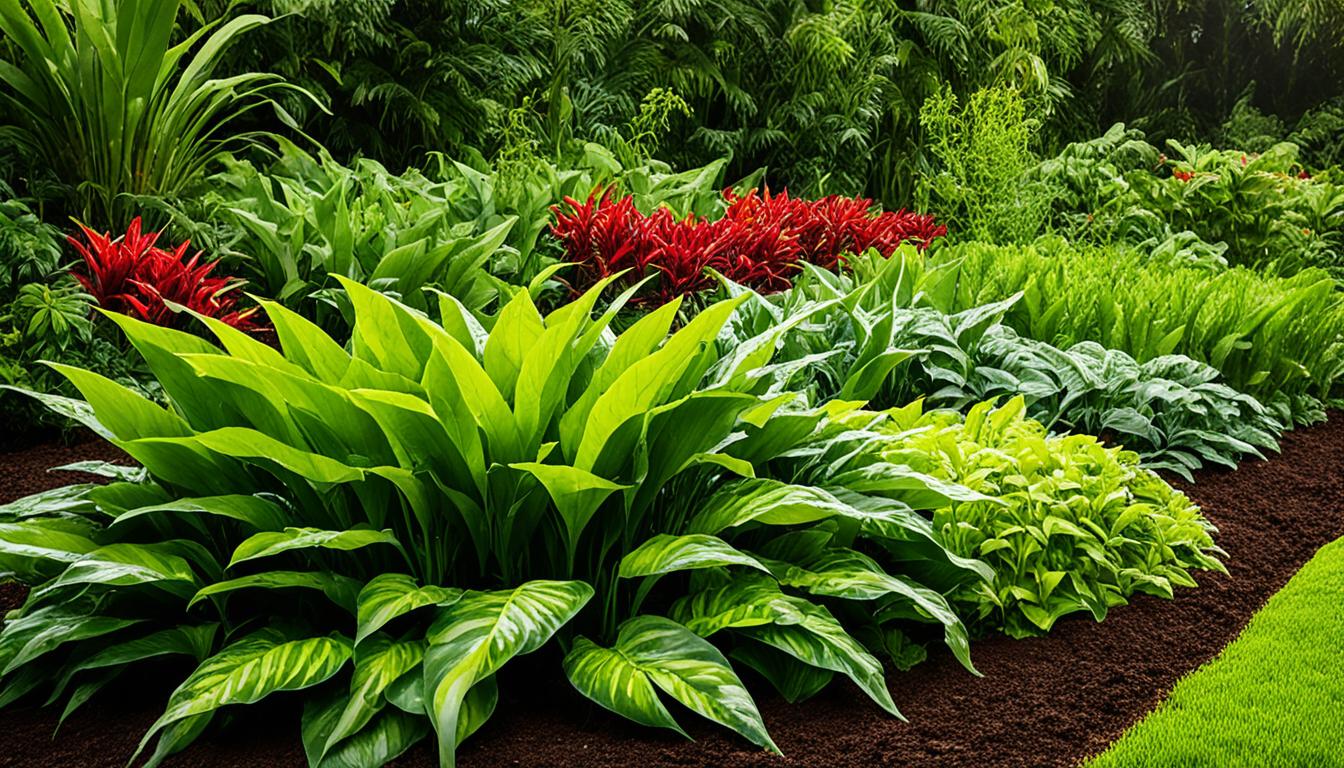
Ginger, known for its unique flavor and medicinal properties, is a versatile root used in everything from cooking to herbal remedies. But did you know that the success of ginger cultivation depends heavily on the conditions in which it is grown? Creating the best conditions for ginger root growth is essential to yield a bountiful harvest and vibrant plants.
From temperature to soil quality and moisture levels, each aspect plays a crucial role in ginger’s growth and well-being. By understanding the optimal conditions, gardeners and enthusiasts can replicate ginger’s tropical habitat and cultivate healthy plants with exceptional flavor and aroma.
In this article, we will explore the optimal conditions necessary for ginger root growth, offering insights and techniques to help you grow ginger successfully. Whether you’re an experienced gardener or a beginner with a green thumb, this guide will provide valuable knowledge to enhance your ginger cultivation.
Key Takeaways:
- Ginger root growth requires specific conditions to thrive.
- Temperature, soil quality, moisture, and shade are essential factors.
- Best practices include using organic matter, maintaining proper drainage, and providing dappled shade.
- Ginger can be grown in containers, hoop houses, or greenhouses.
- Pre-sprouting ginger indoors can maximize the growing season.
Optimal Soil Conditions for Ginger Root Growth
Ginger plants require optimal soil conditions to thrive and produce healthy root growth. By providing the right environment, gardeners can ensure that their ginger plants receive the necessary nutrients and support for robust growth. Here are some essential factors to consider when creating optimal soil conditions for ginger root growth:
- Rich in Organic Matter: Ginger prefers soil that is rich in organic matter, which provides essential nutrients and promotes healthy root development. Adding lots of compost to the ground or using a peat and wood bark-based soilless medium mixed with sand in containers can help create a fertile growing medium.
- Organic Fertilizers and Worm Castings: Supplementing the soil with organic fertilizers and worm castings can further enhance the nutrient content, ensuring that ginger plants have access to the necessary elements for their growth. These natural amendments provide a slow-release source of nutrients, promoting long-term plant health.
- Good Drainage: It is crucial to ensure good drainage in the soil to prevent waterlogging, as standing water can negatively affect ginger growth. To improve drainage, incorporating coarse sand or perlite into the soil can help create a well-draining environment for the roots.
- pH Levels: Maintaining the right pH levels is essential for optimal ginger growth. Ginger plants prefer slightly acidic soil, with pH levels between 5.5 and 6.5. Testing the soil’s pH and making appropriate adjustments using organic soil amendments or sulfur can help create the ideal conditions for ginger plants.
By creating soil conditions that are rich in organic matter, well-draining, and with the right pH levels, gardeners can provide the optimal environment for ginger root growth. The next section will explore the ideal temperature range for ginger plants and the impact it has on their growth and development.
Soil Conditions for Ginger Root Growth
| Soil Condition | Description |
|---|---|
| Rich in organic matter | Ginger prefers soil that is rich in organic matter, such as compost or a peat and wood bark-based soilless medium mixed with sand. |
| Organic fertilizers and worm castings | Adding organic fertilizers and worm castings can provide essential nutrients for ginger plants. |
| Good drainage | Ensuring good drainage in the soil is crucial to prevent waterlogging, which can negatively affect ginger growth. |
| pH levels between 5.5 and 6.5 | Maintaining slightly acidic soil with pH levels between 5.5 and 6.5 is ideal for ginger plants. |

Ideal Temperature Range for Ginger Root Growth
Ginger is a tropical plant that thrives in warm temperatures, making the ideal temperature range a crucial factor for its successful growth. The ideal temperature range for ginger root growth is 70° to 90°F (21° to 32°C). This range provides the optimal conditions for ginger plants to thrive and produce healthy rhizomes.
When growing ginger, it is important to consider the nighttime temperatures as well. It is recommended to plant ginger when nighttime temperatures are consistently above 55°F (13°C). Cooler temperatures can slow down the growth of ginger plants or even cause damage to them, hindering their development.
In regions with colder climates, it may be challenging to maintain these ideal temperatures for ginger growth. However, there are ways to overcome this obstacle and still grow ginger successfully. Growing ginger indoors in a controlled environment, such as a greenhouse or conservatory, can provide the necessary warmth for ginger plants to thrive.

Importance of Moisture for Ginger Root Growth
Ginger is a moisture-loving plant that requires consistent watering to thrive and produce healthy and flavorful roots. Proper moisture management is essential for ginger root growth.
The soil should be kept evenly moist, providing enough water to meet the plant’s needs without overwatering or allowing the soil to dry out completely. Overwatering can lead to waterlogged conditions, which can suffocate the roots and promote the development of root rot. Conversely, letting the soil dry out completely can cause stress to the plant and hinder its growth.
Watering frequency may vary depending on factors such as the climate, humidity levels, and container size. In general, it is advisable to water ginger plants whenever the top inch of soil feels slightly dry. This allows for proper hydration without risking waterlogging.
Proper irrigation techniques and good drainage are crucial for maintaining the ideal moisture levels for ginger root growth. In containers, ensure that there are drainage holes to prevent water from pooling at the bottom. For in-ground planting, selecting a well-draining soil or amending the soil with organic matter can improve moisture balance.
Expert Tip:
When watering ginger plants, it’s important to give them a deep soak, allowing the water to penetrate the root zone. However, avoid overhead watering as it can lead to the development of fungal diseases. Instead, direct the water towards the base of the plant or use a drip irrigation system to ensure precise watering.
By maintaining the right moisture levels through proper watering techniques and good drainage, gardeners can provide the optimal conditions for ginger root growth, ensuring healthy plants and a bountiful harvest.

Moisture Guidelines for Ginger Root Growth
| Moisture Level | Signs | Recommended Action |
|---|---|---|
| Soggy or Waterlogged | Wilting, yellowing leaves; foul odor; root rot | Improve drainage by adding organic matter; reduce watering frequency |
| Too Dry | Wilting, dry soil; slow growth | Increase watering frequency; mulch around plants to retain moisture |
| Evenly Moist | Healthy foliage; steady growth | Continue regular watering; monitor moisture levels |
Benefits of Dappled Shade for Ginger Root Growth
Ginger plants thrive in dappled shade, which provides them with a balanced environment for optimal growth. The benefits of dappled shade include protection from direct sunlight, prevention of soil overheating and excessive drying, and maintenance of suitable moisture levels.
Planting ginger under the shelter of taller crops or using shade cloth can create the perfect conditions for ginger root growth. The dappled shade allows the plants to receive filtered sunlight, which is essential for photosynthesis while reducing the risk of sunburn or heat stress.
“Dappled shade is like a natural sunscreen for ginger plants, shielding them from the harsh rays of the sun and maintaining a cool, comfortable environment.”
By providing dappled shade, you can create an ideal microclimate for ginger root growth. The shade helps regulate soil temperatures, preventing it from becoming too hot and drying out too quickly. This is particularly important for ginger, as it prefers consistently moist soil.
Moreover, dappled shade helps to reduce water evaporation, allowing the roots to stay moist for longer periods. This helps the ginger plants establish a strong root system and absorb essential nutrients from the soil, promoting healthy growth and development.
When setting up dappled shade for your ginger plants, it is important to strike a balance. While providing shade, ensure that there is still enough light penetration for proper photosynthesis. Ginger plants need adequate sunlight to produce energy for growth, but too much direct sunlight can be detrimental.
Consider planting ginger in an area where it receives morning sun and partial afternoon shade. This allows the plants to benefit from the warmth and light of the morning sun while being shielded from the intense heat of the afternoon sun.
To summarize, dappled shade provides numerous benefits for ginger root growth, including protection from direct sunlight, prevention of soil overheating and excessive drying, and maintenance of suitable moisture levels. By implementing dappled shade techniques, you can create an ideal environment for ginger plants to thrive and produce a bountiful harvest.
Pros and Cons of Dappled Shade for Ginger Root Growth
| Benefits of Dappled Shade | Considerations for Dappled Shade |
|---|---|
| Protection from direct sunlight | Ensure there is still enough light for photosynthesis |
| Prevents soil overheating | Find a balance between shade and sunlight |
| Reduces soil drying out | Choose an area with morning sun and partial afternoon shade |
| Maintains suitable moisture levels |

Recommended Planting Techniques for Ginger Root Growth
When it comes to cultivating ginger, selecting the right planting technique is crucial for successful root growth. Whether using whole rhizomes or cut pieces, understanding the proper methods will optimize your ginger harvest. Here are some recommended planting techniques:
1. Using Whole Rhizomes
Planting ginger with whole rhizomes is a straightforward technique that yields excellent results. Look for healthy, plump rhizomes with well-developed buds or eyes. These larger rhizomes tend to grow quicker and produce more robust plants.
To plant whole rhizomes:
- Prepare the soil by loosening it with a garden fork or tiller.
- Dig a trench that is about 6 to 8 inches deep.
- Place the rhizomes in the trench with the eyes facing upwards.
- Cover the rhizomes with soil, ensuring they are well-buried but not too deep.
- Water gently to settle the soil.
2. Using Cut Rhizome Pieces
If you have limited planting material or want to maximize your ginger yield, using cut rhizome pieces is a viable option. When cutting the rhizomes, ensure each piece has at least one bud or eye.
To plant cut rhizome pieces:
- Prepare the soil or select a suitable container with good drainage.
- Fill the container with a well-draining potting mix or amend the soil with organic matter.
- Place the cut rhizome pieces in the soil or container, burying them about 1 to 2 inches deep.
- Water thoroughly to encourage root establishment.
Note: Make sure there is adequate room for the rhizomes to grow when planting in containers. This will prevent overcrowding and promote healthier plant development.
3. Pre-sprouting Indoors
For gardeners who wish to extend the growing season or gain a head start on ginger production, pre-sprouting indoors is an effective technique. This method involves placing the rhizomes in a tray with moist compost or paper towel to encourage early sprouting.
To pre-sprout ginger indoors:
- Select healthy rhizomes with visible eyes.
- Fill a tray with moist compost or lay paper towels on a flat surface.
- Place the rhizomes on the compost or paper towels, positioning them with the eyes facing upwards.
- Maintain the moisture level by misting regularly.
- Keep the tray or paper towels in a warm location with indirect sunlight.
- Once sprouts have developed, carefully transplant them into individual containers or directly into the ground.
Pre-sprouting allows for an earlier harvest and ensures that the ginger plants have a strong start before being exposed to outdoor conditions.
Remember, ginger responds well to a warm and humid environment, so providing the optimal conditions during the planting process will contribute to its overall growth and development.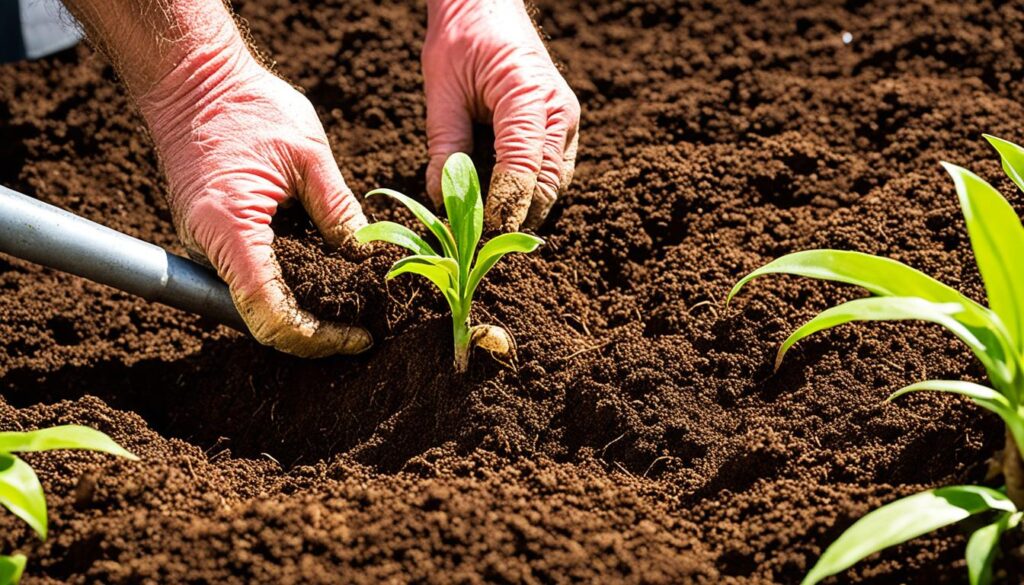
| Planting Technique | Advantages | Disadvantages |
|---|---|---|
| Using Whole Rhizomes | – Quicker growth – Larger harvests |
– Requires more planting material – Limited control over spacing |
| Using Cut Rhizome Pieces | – Maximizes planting material – Allows for precise spacing |
– Slower initial growth – Smaller rhizome yields |
| Pre-sprouting Indoors | – Provides an early start – Enhances germination rates |
– Requires additional indoor space – Requires regular misting |
Care Tips for Ginger Root Growth
Proper care is crucial for the successful growth of ginger roots. By providing the right conditions, you can ensure healthy plants and a bountiful harvest. Here are some essential care tips for ginger root growth:
1. Warmth: Ginger plants thrive in warm environments, so it’s important to provide them with a suitable temperature. During the summer, whether you are growing ginger outdoors or indoors, it’s beneficial to place the plants in a warm and humid area.
2. Humidity: Humidity is another important factor for ginger root growth. If you are growing ginger indoors, placing the plant near a bright windowsill can help simulate the ideal conditions. Additionally, occasional misting with water can create a humid environment that mimics the plant’s natural habitat.
3. Moisture: Adequate moisture levels are essential for ginger plants. It’s important to water the plants regularly, ensuring that the soil is evenly moist. However, be cautious not to overwater, as excessive moisture can lead to root rot. To promote proper drainage, use pots with drainage holes and allow the soil to dry out slightly between waterings.
4. Mulching: Applying a layer of mulch around ginger plants can serve multiple benefits. Mulching helps to conserve moisture in the soil, reducing the frequency of watering required. Additionally, it helps to suppress weed growth, keeping the area around the ginger plants clean and tidy.
Ginger plants require a combination of warmth, humidity, moisture, and proper drainage to thrive. By following these care tips, you can create optimal conditions for ginger root growth and enjoy a successful harvest.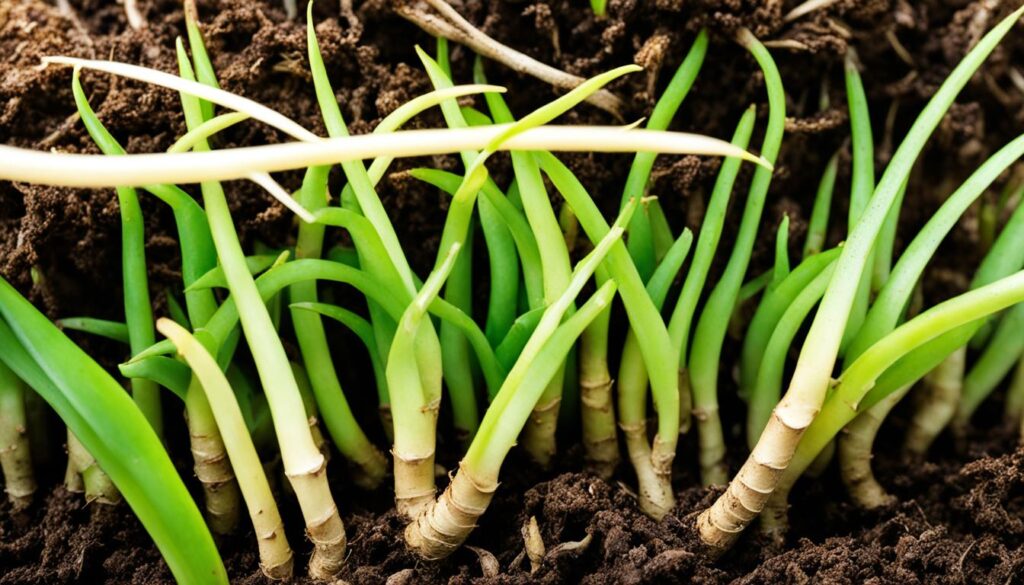
| Care Tips for Ginger Root Growth | Benefits |
|---|---|
| Provide warmth | Creates a favorable environment for ginger plants |
| Maintain humidity | Simulates the plant’s natural habitat and supports growth |
| Ensure proper moisture | Prevents drying out or waterlogging |
| Use mulch | Conserves moisture and suppresses weed growth |
Conclusion
Growing ginger successfully requires replicating its tropical natural habitat as closely as possible. Providing optimal soil conditions, the right temperature range, adequate moisture, and dappled shade is crucial. By following these best practices, gardeners can ensure the best conditions for ginger root growth and enjoy a bountiful harvest.
When it comes to planting ginger, there are two main methods: using whole rhizomes or cutting them into pieces and pre-sprouting indoors for an earlier harvest. Both approaches can be effective, but it’s important to pay careful attention to watering and drainage. Ginger cannot tolerate standing water or drying out completely, so finding the right balance is key.
Remember that ginger thrives in warm temperatures, ideally ranging from 70° to 90°F (21° to 32°C). Additionally, ginger plants appreciate some dappled shade, as it protects them from direct sunlight and helps prevent the soil from drying out too quickly. Creating these optimal conditions will give your ginger the best chance to grow and thrive.
So whether you’re growing ginger in the ground, in containers, or in a greenhouse, make sure to provide it with the right environment. By replicating its tropical natural habitat as closely as possible and paying attention to its specific needs, you can enjoy a bountiful harvest of delicious and aromatic ginger roots.
FAQ
What are the best conditions for ginger root growth?
What are the optimal soil conditions for ginger root growth?
What is the ideal temperature range for ginger root growth?
How important is moisture for ginger root growth?
What are the benefits of dappled shade for ginger root growth?
What are the recommended planting techniques for ginger root growth?
What are the care tips for ginger root growth?
- About the Author
- Latest Posts
Meet Katherine, the creative enthusiast at ByRetreat who infuses her boundless passion for design into every remote workspace she crafts. With an innate sense of creativity and an eye for unconventional beauty, Katherine brings a unique and inspiring perspective to the team.
Katherine’s love for design is infectious, and her ability to think outside the box sets her apart. She believes that true artistry lies in embracing a variety of styles and mixing them harmoniously to create captivating spaces. By combining different textures, colors, and patterns, Katherine weaves a tapestry of creativity that breathes life into each remote workspace.
-

 Vetted5 days ago
Vetted5 days ago15 Best Printers of 2024: Top Picks and Expert Reviews
-

 Vetted1 week ago
Vetted1 week ago15 Best Tile Sealers for Long-Lasting Protection and Shine
-

 Vetted2 weeks ago
Vetted2 weeks ago15 Best Smelling Floor Cleaners That Will Leave Your Home Fresh and Inviting
-

 Vetted1 week ago
Vetted1 week ago14 Best Power Scrubbers for Showers That Will Transform Your Cleaning Routine
-

 Vetted2 days ago
Vetted2 days ago15 Best Evergreen Plants for Shade Gardens: A Complete Guide
-

 Vetted2 days ago
Vetted2 days ago15 Best LED Dimmer Switches With No Flicker: Ultimate Guide for a Flicker-Free Lighting Experience
-

 Mardi Gras Decoration4 days ago
Mardi Gras Decoration4 days agoWhat Do the Symbols of Mardi Gras Mean?
-

 Appliances1 week ago
Appliances1 week ago5 Best Energy-Efficient Stainless Steel Fridges 2023




























